ABSTRACT
The goals of the present study were to identify resistant mandarin varieties with potential for the fresh fruit market that could enable an extension of the harvesting season and to develop appropriate methods to maintain fruit quality for longer storage periods. Fremont mandarin fruits were harvested at optimum maturity and stored with and without wax coating under different storage conditions: ambient (21 ± 2°C and 60 ± 5% relative humidity (R.H.)) and under refrigeration (8 ± 2°C and 90 ± 5% R.H.). Fruit physicochemical characteristics and acceptability and purchase intention, which were assessed through sensory analysis, were evaluated weekly. Mass loss was higher for fruits stored at ambient temperature. The soluble solids concentrations of fruits stored under refrigeration remained similar to the values measured at harvest. Fruits stored under refrigeration exhibited slightly higher gloss and color than fruits stored at ambient temperature. Wax-coated fruits exhibited lower mass loss and higher gloss and color than uncoated fruits. Similar results were observed for the sensory analysis: wax-coated fruits stored under refrigeration were better rated by panelists until the final evaluation (day 35 after the beginning of storage). Purchase intention was higher for fruits stored under refrigeration than at ambient temperature. It is concluded that uncoated fruits stored at ambient temperature exhibit a tendency to lose quality, which confirms the need for refrigeration and wax coating for post-harvest preservation of fresh citrus fruits. However, the physicochemical and sensory qualities of Fremont mandarins stored under refrigeration for 30 to 35 days are accepted by consumers.
Key words: Citrus spp., preservation, refrigerated storage, sensory analysis, post-harvest.
China is the largest global producer of mandarins, with a production of approximately 15 million tons (mi t), more than 50% of which is aimed at the internal market, followed by Spain (2 mi t), who is responsible for most of the global export production, and Turkey, with a production of 942 thousand tons. Brazil is the fourth largest global producer of mandarins, with 938 thousand tons produced in 2013 (Food and Agricultural Organization (FAO), 2015). In spite of Brazil's prominence, the existing range of mandarin varieties is still very limited. More than 80% of the mandarin orchards in Brazil are based on Ponkan mandarins (Citrus reticulata Blanco) and Murcott tangor [C. reticulata × C. sinensis (L.) Osbeck]. New research is being developed to identify varieties that are easy to peel, that have a homogeneous and attractive color, and that may result in an extended harvesting season, thereby constituting an additional source of income for small citrus producers (Pimentel et al., 2014). This is the case for Fremont mandarin, a hybrid resulting from the crossing between Clementine (C. clementina Hort. ex Tanaka) and Ponkan (C. reticulata Blanco) mandarins. Fremont is a promising variety because it exhibits precocious maturation in mid-season, a yellow-red fruit peel, a fruit shape and peel texture that are very similar to clementines (Saunt, 1990), resistance to Alternaria alternata, the fungus responsible for Alternaria brown spot (Pacheco et al., 2012), and is productive under Brazilian conditions (Pio et al., 2006).
The quality of citrus fruits is extremely important for their commercialization in the fresh fruit market. Quality is basically evaluated through an analysis of the fruit physicochemical characteristics (size, color, texture, acidity, soluble solids, SS/TA ratio) and sensory properties (product analysis using the sense organs). Many of these characteristics are specific to a particular cultivar or are influenced by climate conditions. However, some of them, such as appearance, flavor and texture, may be improved through pre- or post-harvest techniques (Malgarim et al., 2007).
The permanent supply of fresh fruit to the market is increasingly important, making it necessary to extend the fruit offer by extending the harvesting season. The mandarin harvesting season is relatively short and may be extended using technological operations. If well conducted, these will minimize post-harvest losses as well as maintain fruit quality and extend the period of commercialization. These fruits therefore reach the internal and/or external market when the prices are more profitable (Nascimento et al., 2011). Sensory analysis, which indicates how the fruits are perceived by the human senses, complements physicochemical analysis and is essential to assess, analyze and interpret the reactions produced in response to food characteristics. This type of analysis is used for quality control by many companies because it can be used to evaluate the degree of product acceptance by consumers and because it indicates what changes need to be made to increase product acceptance, which increases consumers’ preference for specific products in an increasingly demanding market (Manzocco and Lagazio, 2009).
The Brazilian citrus industry lacks new varieties for fresh consumption and often new varieties are not accepted by the producer. Consequently, the goal of the present study was to evaluate the physical, chemical and sensory quality of new variety, Fremont mandarin, which were uncoated or coated with commercial wax, at different storage times and under different storage conditions. It´s also with the objective of minimize losses and maintain fruit quality, and verify their acceptability and purchase intent by Brazilian consumers.
Post-harvest assay (storage)
The experiment was conducted at the Laboratory of Citrus Quality and Post-harvest of the Citrus Center Sylvio Moreira of Agronomic Institute (IAC), Cordeirópolis, São Paulo (SP), Brazil. Ripe fruits of the Fremont IAC 548 variety (Citrus clementina x C. reticulata Blanco) were used. The fruits were collected in June 2012 from three-year-old plants grafted onto Rangpur lime rootstock and planted at a 6 m x 3 m spacing (Figure 1).
The fruits were surface sterilized with 5% sodium hypochlorite, dried, and subjected to physicochemical analyses. The following parameters were evaluated: (i) fresh mass (g), measured by direct weighing using a digital scale with a precision of 5 g; (ii) longitudinal (Ǿ L) and transverse (Ǿ T) diameter, in centimeters, measured directly using a digital caliper; (iii) juice yield, determined by squeezing the fruit using a juice extractor OIC OTTO 1800 and calculated as the juice mass/fruit mass ratio, expressed as a percentage (%); (iv) fruit mass loss, calculated as the difference between the initial fruit mass and the fruit mass on each sampling day, expressed as a percentage (%); (v) fruit peel gloss, measured at two equidistant points on the equatorial region of the fruits, using a Glossmeter ETB6-F1; (vi) firmness, measured by applying pressure at two equidistant points on the equatorial region of the fruits, using a digital penetrometer (Turoni); and (vii) acidity (%), soluble solids - SS (°Brix), and the soluble solids/acid ratio; fruit peel color, determined through determination of L* (lightness), a* (intensity of red color, ranging from green to red), and b* (intensity of yellow color, ranging from blue to yellow), using a digital colorimeter (Minolta CR-400) (Papadakis et al., 2000). a* and b* were used to calculate the hue angle (ºh=tan-1(b*/a*)) and chroma (c*=√(a*)2+(b*)2), which is a measure of the color strength.
The collected fruits were subjected to the following storage treatments: fruits with or without wax coating stored under refrigeration (8 ± 2°C and 90 ± 5% R.H.), and fruits with or without wax coating stored at room temperature (21 ± 2°C and 60 ± 5% R.H.), i.e., the control. Wax coating was performed using commercial wax combined with fungicides to avoid the development of typical post-harvest pathogens (UE Wax, 16% citrosol + 4.0 mL Imazalil + 1.0 L UE Polyethylene + starch), according to the procedures used in processing units. Physicochemical analyses (described previously) were performed weekly until 42 days after the beginning of storage. A completely randomized experimental design with split-plots was used, replicated three times. The factors tested were storage time (six weeks), storage conditions (ambient and refrigerated), and wax coating (coated and uncoated). The plots consisted of 10 fruits for the mass loss assay, and 28 fruits per box for the storage assay. Regression analyses were performed, and models were selected for each variable based on the significance of the parameters and the R2 value.
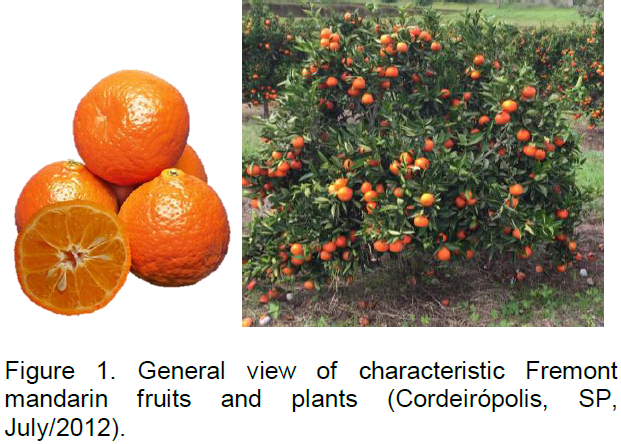
Sensory analyses
Sensory analyses were performed weekly to determine the acceptance and purchase intention of Fremont mandarins. The evaluations were performed by a team composed of 10 panelists who are employees of the Citrus Center Sylvio Moreira and who consume mandarins weekly; their ages range between 25 and 60 years old. The samples were identified using four number codes and were presented to the panelists on disposable plates in the presence of drinking water to cleanse the palate between samplings. The panelists evaluated the appearance of the fruit (general appearance, peel color, peel texture, firmness, ease of peeling) and internal characteristics (consistency, aroma, flavor). A nine-point hedonic scale, varying from “dislike extremely” (1) to “like extremely” (9) (Behrens et al., 1999), and a structured five-point purchase intention scale, varying from "certainly would buy" (5) to "certainly would not buy" (1), were used. Data were collected using individual sheets. The present study received ethics approval from the Human Research Ethics Committee from the Federal University of São Carlos (UFSCar) according to protocol N° 2305.0.000135-11. All panelists signed an informed consent form before participating in the study (Resolution 196/96 - National Health Council). Data were subjected to analysis of variance and means were compared by Tukey test (p < 0.05).
Physicochemical characterization of Fremont mandarins in post-harvest assay (storage)
The Fremont mandarin fruits used in the post-harvest assay were collected in June, that is, at their optimum maturity point (Table 1). These fruits presented a SS/TA ratio higher than 11, an average weight of 125.5 g, a juice yield of approximately 45%, a soluble solid concentration (SS) of 11.16 °Brix, a titratable acidity (TA) of approximately 1.0%, a longitudinal diameter of 6.7 cm, and a transverse diameter of 5.7 cm. However, the fruit peel and pulp presented different colors (51.11 h° and 39.98 h°, respectively). Changes in the evaluated parameters (mass loss, acidity, soluble solids, SS/TA ratio, gloss, texture and hue angle) were observed over storage time. Mass loss, soluble solids concentrations, the SS/TA ratio and texture increased during storage. In contrast, titratable acidity, gloss and peel color presented a slight decrease over time (Figures 2, 3, 4 and 5). The fruits stored under ambient conditions presented a higher mass loss, soluble solids concentration and SS/TA ratio, and a lower gloss and hue angle compared with the refrigerated fruits. In addition, the refrigerated fruits presented a relatively lower mass loss, and the soluble solids concentration, soluble solids/acid ratio, gloss and hue angle (h°) were similar to the values observed at the beginning of storage. The wax coating only affected the soluble solids/acid ratio, gloss and color, that is, the wax-coated fruits presented a higher soluble solids/acid ratio, gloss and hue angle.

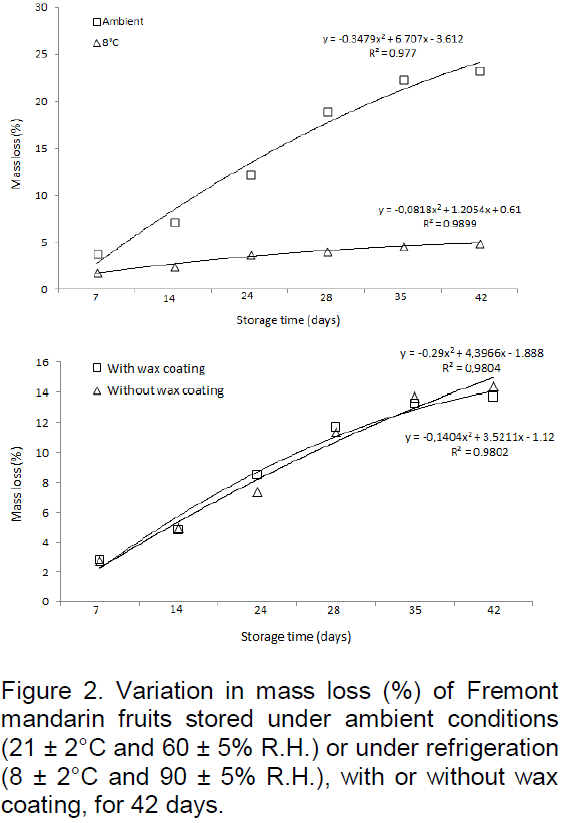
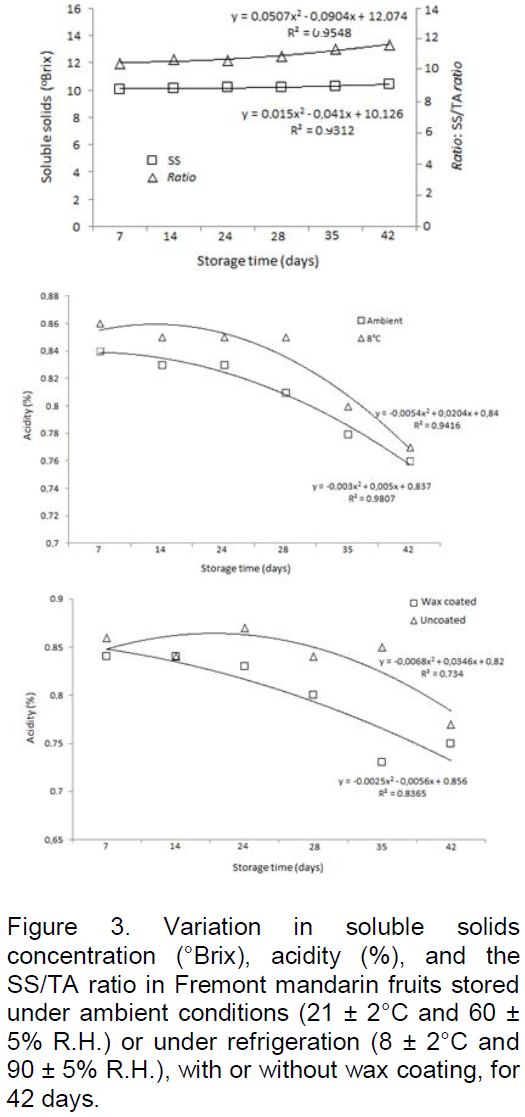
Sensory quality of Fremont mandarins with different storage times
The fruits stored under refrigeration presented higher acceptability for all evaluated characteristics (appearance, firmness, ease of peeling, and flavor) (Table 2). In general, the fruits stored under refrigeration presented a better appearance than the fruits stored under ambient conditions, independent of wax coating. The appearance of fruits stored under refrigeration was rated between “like very much” and “like slightly” throughout storage, whereas the acceptance of the appearance of fruits stored under ambient conditions decreased with storage, ranging from “like moderately” to “dislike slightly”, by day 35 of storage.
Fruit firmness decreased by day 14 for all treatments. However, this firmness loss was lower for the fruits stored under refrigeration than for the fruits stored under ambient conditions, which exhibited a pronounced decrease in firmness by day 28 of storage, independent of wax coating. The wax-coated fruits presented a lower ease of peeling from week 4 (day 28) when stored under ambient conditions and an increased ease of peeling from day 14 when stored under refrigeration.

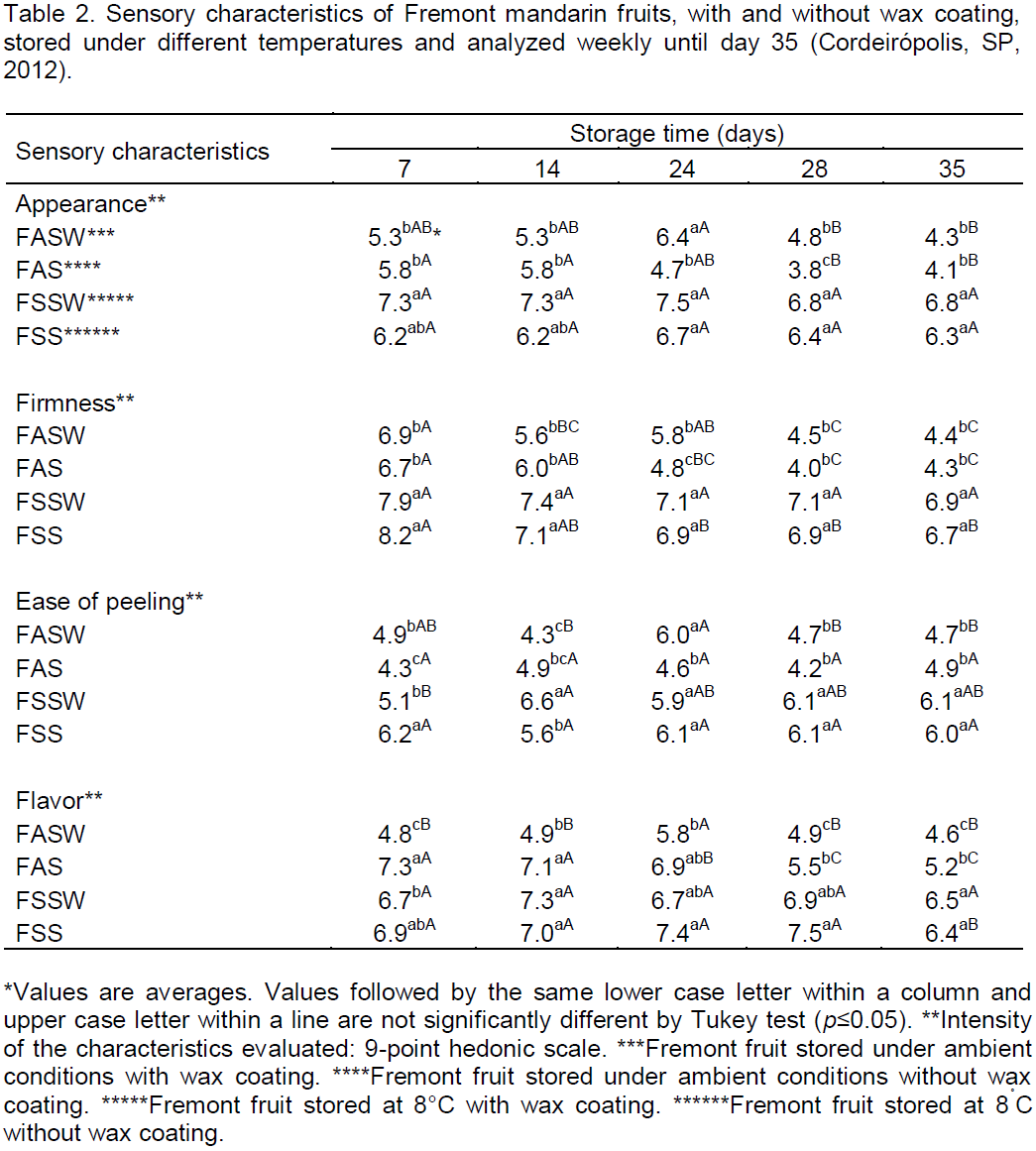
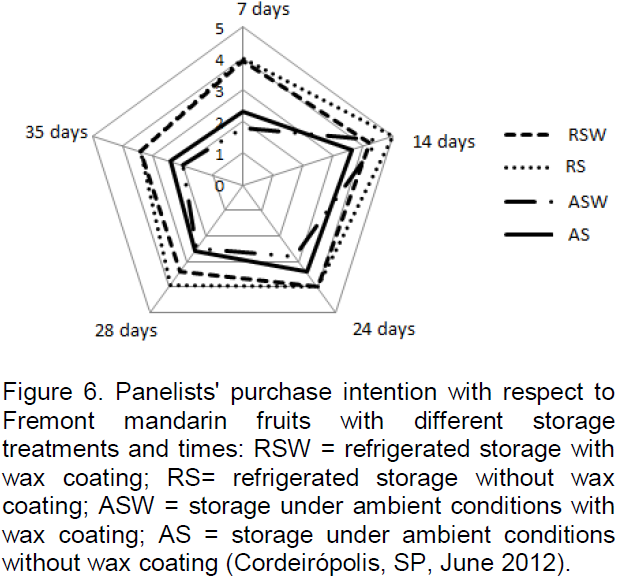
The wax-coated fruits presented a change in flavor inthe first week of storage but later recovered a pleasant flavor (Table 2). The fruits stored under refrigeration presented a better flavor than the ones stored under ambient conditions; the wax-coated fruits maintained their flavor characteristics until day 35 and subsequently became unsuitable for consumption. Uncoated fruits stored under refrigeration presented an improved flavor in the third week of storage (day 24) and only began presenting a decreased flavor in the fifth week (day 35). However, the flavor of the fruits stored under ambient conditions, with or without wax coating, started changing in the fourth week of storage (day 28), receiving an average rating of approximately 4 (“dislike slightly”). It should be highlighted that wax-coated fruits stored under ambient conditions were rated lower than the uncoated fruits stored under ambient conditions. However, the purchase intention was higher for the fruits stored under refrigeration compared with those stored under ambient temperature. The refrigerated fruits were rated by the panelists as “might or might not buy it” (a rating of 3) only between days 28 and 35 of storage, whereas doubts regarding the purchase intentions of the panelists for fruits stored under ambient conditions were observed from day 24 of storage, with ratings between 3 and 2 (“might or might not buy it” and “probably would not buy it”, respectively) until the end of the evaluations (Figure 6).
The Fremont mandarin fruits used in the present study presented 0.97% acidity, 11.16 °Brix and a SS/TA ratio of 11.50, that is, a very good sugar-acid balance, which is appropriate for commercialization and consumption (CEAGESP, 2011). An acidity of approximately 1% is important for the industrial use of citrus fruits, allowing flexibility of sugar addition for the production of ready-to-drink beverages and making deterioration by microorganisms more difficult (Franco, 2005). The optimum SS/TA ratio range for industrial processing of citrus fruits is reported to be between 8.8 and 15.4, according to Sartori et al. (2002), and 12 and 13, according to Couto and Canniatti-Brazaca (2010).
Ponkan, the main mandarin variety commercialized in Brazil, presents 138 g average weight, 43% juice yield, 10.8 °Brix, 0.85% acidity and a 12.7 SS/TA ratio (Pio et al., 2005). Fremont mandarins present similar characteristics to Ponkan mandarins, except for the smaller fruits, with a higher longitudinal/transverse diameter ratio, which is characteristic of oblong fruits (Table 1). The juice yield is higher for Fremont (44.8%) compared with Ponkan mandarins (43%). Fremont mandarins are juicier, present a higher total soluble solids concentration, a low-acid flavor, and pleasant taste and do not cause gastric discomfort (Frata; Valim; Monteiro, 2006). Another positive aspect of Fremont mandarins, from a consumer point of view, is the peel color, which is bright orange (Hue angle of 51.11), whereas Ponkan mandarins present a yellow orange color (Hue angle between 62.6 and 76.9; Silva et al., 2014). Peel color is considered a very important quality parameter for the fresh fruit market, being one of the factors determining fruit acquisition by consumers, which may please both the fresh fruit market and the juice processing industry (Santos et al., 2010). In general, mandarin varieties and hybrids with orange color are more highly accepted by consumers (Pio et al., 2001).
The Fremont variety is recommended for the fresh fruit market and, because it presents different fruits, can reach very interesting prices for producers. Due to the quality of its pulp, the juice of Fremont mandarins may also be featured in agroindustry as a different type of mandarin juice aimed at the internal market, although the fresh fruit market pays better for this type of product (ASSOCITRUS, 2012). Fruit mass loss was more pronounced for storage under ambient conditions (Figure 2). This results from higher water loss due to transpiration, caused by differences in water vapor pressure between the fruit and the ambient air (Sousa et al., 2000). A lower temperature under refrigeration lowers fruit metabolism, resulting in lower mass loss (Jeronimo and Kanesiro, 2000). This is extremely important for commercialization because high mass loss may result in withering and loss of fruit consistency, resulting in decreased quality.
Small variations in SS concentrations were observed (Figure 3). Mass loss during storage contributes to an increase in sugar concentration. These small changes in SS are common because the sugar content of citrus fruits changes when the harvest is performed during or following the maturation stage (Chitarra and Chitarra, 2005). In contrast, acidity decreased during storage (Figure 3). Acidity decreases following harvest and during storage in most fruits because the concentration of organic acids tends to decrease due to their use as a respiration substrate and source of carbon skeletons for the synthesis of new compounds (Kays, 1991). This observation was previously reported by Malgarim et al. (2008) for Nova tangelo fruits (C. reticulata Blanco × C. paradisi Macfad.).
In contrast, increases in the SS/TA ratio were observed during storage. This effect was also reported by Lima et al. (1999), who studied the quality of Ponkan mandarins stored under ambient temperature. The SS/TA ratio tends to increase during fruit maturation due to a decrease in acids and an increase in sugars. The SS/TA ratio varied between 11 and 13, which is in agreement with the maturity index for citrus fruits. Kluge et al. (2007) reported a SS/TA ratio between 10.79 and 14.87 for Murcott tangor and between 9.24 and 11.13 for Valencia oranges, under refrigerated storage. The higher ratings given to fruits stored under refrigeration compared with ambient conditions, independent of wax coating, are associated with the sugar/acid balance. One characteristic stands out relative to the others. In the case of fruits, the characteristic that is most taken into consideration is the fruit sugar concentration (ABNT, 1993; Anzaldúa-Morales, 1994).
The pressure applied to the wax-coated fruits was practically constant during storage, with a penetration force varying between 4.5 N and 5.9 N from the beginning to the end of storage (Figure 4). This result supports the use of wax coating for maintenance of fruit turgidity because it decreases the loss of water from the fruit to the external medium by changing the air surrounding the fruit (Hagenmaier and Baker, 1994). Wax coating of Tahiti acid limes also delayed the occurrence of changes in the fruit cell walls; these changes resulted in a wilted appearance and difficulty in penetrating the fruit surface with a penetrometer (Jomori et al., 2003).
The firmness of the fruits stored under refrigeration was better rated by the panelists than that of the fruits stored under ambient conditions, independent of wax coating. Consumers consider fruit texture an indicator of quality, that is, product freshness, and this factor contributes to the purchase decision (Surmacka-Szczesniak, 2002). Fruit peel gloss slightly decreased with storage under ambient conditions, and the fruits became duller (Figure 5). Peel color and gloss are the quality attributes that most influence the purchase decision, and these factors depend on storage conditions (Gvozdenovi
ć et al., 2000). The fruit peel gloss of Navelina oranges has been reported to decrease during storage, especially for uncoated fruits (Malgarim et al., 2007). This explains the better acceptance of fruits stored under refrigeration compared with those stored under ambient conditions, independent of wax coating, because visual appearance is generally the first contact consumers have with a product, and they show a preference for color and appearance. All products possess expected colors and appearances, which are associated with personal reactions of acceptance, indifference or rejection by panelists (Anzaldúa-Morales, 1994).
The purchase intention of panelists was highest for uncoated fruits stored under refrigeration and lowest for wax-coated fruits stored under ambient conditions (Figure 6). The maintenance of fruit quality obtained with storage under refrigeration was the main reason for the higher purchase intention of the panelists. The use of refrigeration for storage of citrus fruits is a good alternative for the maintenance of fruit quality and a decrease in post-harvest losses (Hagenmaier and Baker, 1993). It is therefore concluded that fruit quality results from a set of physical, chemical and/or sensory characteristics, which should be preserved during storage, and that a safe storage period should be defined to avoid changes in fruit structures as much as possible.
Fremont mandarins present physicochemical and sensory characteristics that are accepted by Brazilian consumers and may be stored under refrigeration (8 ± 2°C and 90 ± 5% R.H.) for 30 to 35 days without losing these characteristics. Purchase intention was higher for fruits stored under refrigeration than at ambient temperature. It is concluded that uncoated fruits stored at ambient temperature exhibit a tendency to lose quality, which confirms the need for refrigeration and wax coating for post-harvest preservation of fresh citrus fruits.
The authors have not declared any conflict of interests.
To the CNPq (Conselho Nacional de Desenvolvimento Científico e Tecnológico) and Capes (Coordenação de Aperfeiçoamento de Pessoal de Nível Superior) for the research fellowship of the first author. Research supported by Fundação de Amparo à Pesquisa do Estado de São Paulo (FAPESP) (2011/18605-0) and Instituto Nacional de Ciência e Tecnologia (INCT) de Genômica para Melhoramento de Citros (Process #573848/2008-4).
REFERENCES
|
Anzaldúa-Morales A (1994). La evaluación sensorial de los alimentos en la teoría y la práctica. Acribia: Zaragoza. 198p.
|
|
|
|
ASSOCITRUS (2012) – Associação Brasileira de Citricultores. Uma doce opção para a laranja.
View
|
|
|
|
|
Behrens JH, Silva MAAP, Wakeling IN (1999). Affective sensory tests and internal analysis of preference in acceptability assessment of Brazilian varietal white wines. Ciênc. Tecnol. Aliment 19: 214-220.
Crossref
|
|
|
|
|
CEAGESP (2011). Companhia de Entrepostos e Armazéns Gerais de São Paulo. Normas de classificação de citros de mesa. São Paulo 12p.
|
|
|
|
|
Chitarra MIF, Chitarra AB (2005). Pós-colheita de frutas e hortaliças: fisiologia e manuseio. 2. ed. rev. e ampl. Lavras: UFLA 785p.
|
|
|
|
|
Couto MAL, Canniatti-Brazaca SG (2010). Quantificação de vitamina C e capacidade antioxidante de variedades cítricas. Ciênc. Tecnol. Aliment 30:15-19.
Crossref
|
|
|
|
|
FAO (2014) – FAO Statistical Database, Supply Utilization Account.
View.
|
|
|
|
|
Franco BDGM (2006). Microbiologia de Alimentos. São Paulo: Atheneu 196p.
|
|
|
|
|
Frata MT, Valim MF, Monteiro M (2006). Preference mapping of commercial orange juices. Fruit Process. 16:116-121.
|
|
|
|
|
Gvozdenović J, Popov-Raljić J, Curaković M (2000). Investigation of characteristic colour stability of powdered orange. Food Chem. 70:291-301.
Crossref
|
|
|
|
|
Hagenmaier RD, Baker RA (1994). Wax microemulsions and emulsions as citrus coatings. J. Agric. Food Chem. 42:899-902.
Crossref
|
|
|
|
|
Hagenmaier, RD, Baker RA (1993). Reduction in gas exchange of citrus fruit by wax coatings. J. Agric. Food Chem. 41:283-287.
Crossref
|
|
|
|
|
Jeronimo RF, Kanesiro MAB (2000). Efeito da associação de armazenamento sob refrigeração e atmosfera modificada na qualidade de mangas `Palmer'. Rev. Bras. Frutic. 22:237-243.
|
|
|
|
|
Jomori MLL, Kluge RA, Jacomino AP, Tavares S (2003). Cold storage of 'Tahiti' lime: use of 1-methylcyclopropene, gibberellic acid and wax. Rev. Bras. Frutic. 25:406-409.
Crossref
|
|
|
|
|
Kays SJ (1991). Postharvest physiology of perishable plant products. New York: Van Nostrand Reinhold. 532p.
Crossref
|
|
|
|
|
Kluge RA, Jomori MLL, Edagi FK, Jacomino AP, Aguila JAD (2007). Chilling injury and quality of citric fruits submitted to thermal treatments and cold storage. Rev. Bras. Frutic. 29:233-238.
Crossref
|
|
|
|
|
Lima LC, Vilas Boas EVB, Reis JMR, Chitarra AB (1999). Quality of the 'Ponkan' mandarin tree fruits (Citrus reticulata Blanco), stored at room temperature. Rev. Univer. Alf. 5:27-31.
|
|
|
|
|
Malgarim MB, Cantillano RFF, Oliveira RP, Treptow RO (2008). Postharvest quality of the citrus fruit 'Nova' in different cold storage and shelf life periods. Rev. Bras. Agrociência 14:19-23.
|
|
|
|
|
Malgarim MB, Cantillano RFF, Treptow RO (2007). Cold storage of oranges cv Navelina with different concentrations of carnauba wax. Acta Sci. Agron. 29(1):99-105.
Crossref
|
|
|
|
|
Manzocco L, Lagazio C (2009). Coffee brew shelf-life modelling by integration of acceptability and quality data. Food Qual. Pref. 20:24-29.
Crossref
|
|
|
|
|
Nascimento LM, (2011). Storage potential of W Murcott mandarin: refrigerated storage × modified atmosphere. CR & T. 32(3):167-172.
|
|
|
|
|
Papadakis SE, Abdul-Malek S, Kamdem RE, Yam KL (2000). A versatile and inexpensive technique for measuring color of foods. Food Technol. 54:48-51.
|
|
|
|
|
Pacheco CA, Martelli IB, Polydoro DA, Schinor EH, Pio RM, Kupper KC, Azevedo FA (2012). Resistance and susceptibility of mandarins and hybrids to Alternaria alternata. Sci. Agric. 69:386-392.
Crossref
|
|
|
|
|
Pimentel UV, Martins ABG, Barbosa JC, Cavallari LL (2014). Nutrition of 'Flying Dragon', a citrus rootstock. Rev. Bras. Frutic. 36: 495-502.
Crossref
|
|
|
|
|
Pio RM, Azevedo FA, De Negri JD, Figueiredo JO, Castro JL (2006). Characteristics of Fremont variety compared to Ponkan and Clementina Nules mandarins. Rev. Bras. Frutic. 28:222-226.
Crossref
|
|
|
|
|
Pio RM, Figueiredo JO, Stuchi ES, Cardoso SAB (2005). Variedades Copas, in: Mattos Jr D, De Negri JD, Pio RM, Pompeu Jr J (Eds.), Citros. Instituto Agronômico e Fundag, Campinas pp. 429-447.
|
|
|
|
|
Pio RM, Minami K, Figueiredo JO (2001). Fruit characteristics of the span americana (citrus reticulata blanco): an early ripening 'Ponkan' like mandarin. Rev. Bras. Frutic. 23:325-329.
Crossref
|
|
|
|
|
Santos D, Matarazzo HM, Silva DFP, Siqueira DL, Santos CM, Lucena CC (2010). Characterization of citrus apirenic fresh fruit produced in Viçosa, Minas Gerais. Rev. Ceres. 57:393-400.
Crossref
|
|
|
|
|
Saunt J (1990). Citrus varieties of the world. Norwich: Sinclair International. pp. 60-62.
|
|
|
|
|
Sartori IA, Koller OC, Schwarz SF, Bender RJ, Schafer G (2002). Maturação de frutos de seis cultivares de laranjas-doces na depressão central do Rio Grande do Sul. Rev. Bras. Frutic. 24:364-369.
Crossref
|
|
|
|
|
Silva APG, Silva SM, Schunemann APP, Dantas AL, Dantas RL, Silva JÁ, Mendonça RMN (2014). Identity and quality standards for 'ponkan' mandarin produced in the Paraiba state, Brazil. AGROTEC. 35:143-149.
|
|
|
|
|
Sousa RP, Filgueira HAC, Costa JTA, Alves RE, Oliveira AC (2000). Armazenamento de Seriguela (Spondia purpurea L.) sob atmosfera modificada e refrigeração. Rev. Bras. Frutic. 22:334-338.
|
|
|
|
|
Surmacka-Szczesniak A (2002). Texture Is a Sensory Property. Food Qual. Pref. 13:215-25.
Crossref
|
|